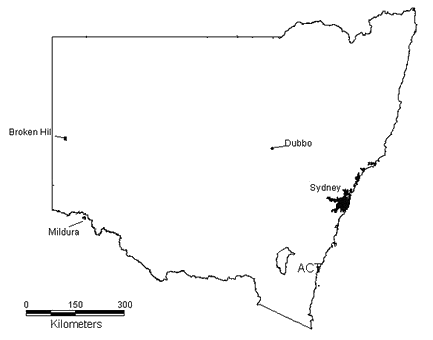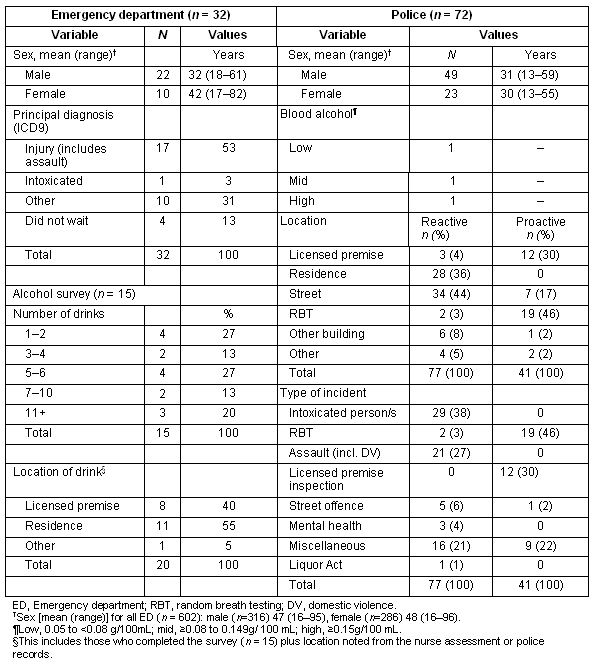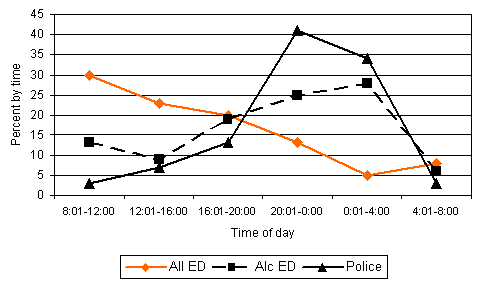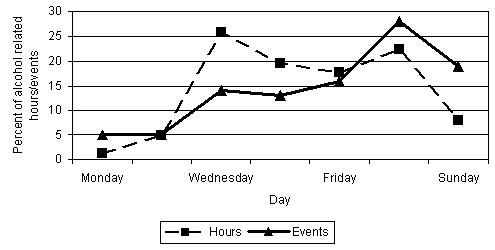Introduction
The burden of disease associated with alcohol is significant1,2 but this has not received the same public attention as illicit drugs3-5. Self-reported risk drinking is increasing6,7 in Australia but declining in the state of New South Wales (NSW)8. The hospitalisation rate for all alcohol attributable conditions and for injuries in NSW is increasing, with higher rates in rural and remote areas8.
In Broken Hill, a regional centre in far west NSW (Fig 1), alcohol-related hospital admissions decreased between 1999 and 2000, and in the period 2004-20056. Self-reported risk drinking in Greater Western Area Health Service (GWAHS), which includes Broken Hill, also declined9 but is still higher than the NSW average. People in the Divisions of General Practice in western GWAHS reported more risk drinking than those in eastern GWAHS, and more than in most urban GP Divisions8,10. Alcohol-related crimes, including drink driving, assaults and domestic violence, were higher in Broken Hill than NSW overall11-13.

Figure 1: New South Wales showing Broken Hill and the nearest larger towns: Mildura (Victoria), Dubbo and Sydney.
The Australian National Alcohol Strategy 2006-200914 recommends strengthening/ exploring data collection at the local level by integrating health and police data in order to develop a better understanding of the extent of alcohol-related harm.
Community feedback to the NSW State Plan15; the re-establishment of the Community Drug Action Team; the newly formed, Broken Hill based, Lower Far West Regional Reference Group to reduce violence against women; and the Barrier Liquor Accord suggest a growing community concern and a commitment to addressing harm caused by alcohol. From the 2006 Census16, Broken Hill local government area had a resident population of just under 20 000, of whom 10% were males aged 20-39 years - the main risk group. Broken Hill is an active mining town so an increase in the number of males in this age range is likely.
In this pilot study we explored the practicality and benefits of integrating alcohol-related police and health data in a remote regional centre.
Method
The study was conducted in different seasons in 2006 (week 1 in June [winter], and week 2 in November [late Spring]) because anecdotally alcohol incidents/ presentations increase in warmer months. These weeks were chosen because they contained no public/ school holidays, special local events or police operations.
Emergency department patient recruitment
Alcohol-related presentations were those that met any one of the following criteria: those who self-reported alcohol consumption via a survey; a nurse's assessment; patients whose incident was flagged as alcohol-related in police records; or those who had a diagnosis of acute alcohol (ICD9 codes).
The nurse assessment is a short narrative of the patient's presenting problem and how it occurred. If the nurse has a reason to believe the patient has been drinking alcohol, questions may be asked about alcohol consumption.
All ambulatory patients 16 years and older who presented at the emergency department (ED) were asked by the triage nurse to complete a short questionnaire about their alcohol consumption. This was in order to maximise the number of participants and to minimise any recruitment bias. However, the triage nurse did not always have time to promote the survey.
Patients were considered ineligible if they were triaged (using the Australasian Triage Scale) as category 1 or 2 patients (requiring immediate resuscitation or treatment within 10 min); did not speak English; or could not give written consent/ complete a questionnaire (eg due to intoxication, other cognitive disability or literacy issues).
The following data were routinely collected: age and sex, time of presentation, triage category, diagnosis, nurse assessment and discharge status.
Survey development
In order to encourage participation the survey questionnaire was one page in length and required only tick-box answers. The questionnaire was derived from previous research17-20 and asked:
- 'Have you had anything to drink (alcohol) in the 6 hours prior to the event that brought you here?'
- 'What were you drinking (eg wine, spirits, light beer)?'
- 'How much did you drink?'
- 'Where did you spend most time while drinking?'.
The following four further questions were asked of patients presenting with an injury, although answers to these questions were often missing and so were not included in the analysis: (i) 'Where were you when the injury happened?' (ii) 'What were you doing when the injury happened?' (iii) 'Was the injury caused by someone else?' (iv) 'If someone else caused your injury, in your opinion was the other person/s affected by alcohol?'.
Police component
Police are required to enter information about alcohol involvement into the Computerised Operational Policing System (COPS) system for each incident they attend. They make a subjective assessment about whether alcohol contributed to the cause of the incident. The COPS number links to other routinely collected data, such as duration, age, sex, location, type of incident, police officer(s) present. All incidents flagged as alcohol-related were classified 'reactive' or 'proactive' incidents. Reactive incidents were those where police investigated an incident that had been reported, or came across the incident during their patrols. Proactive incidents were those initiated by police, such as random breath testing (RBT), or a business inspection of a licensed premise.
Most COPS events start as Computerised Incident Dispatch System (CIDS) records. These narratives were examined to determine if they were alcohol related. To avoid duplication when a COPS event was created from a CIDS narrative, only the COPS data were used by the police investigator. The CIDS narratives often indicate the involvement of more than one person but unless a COPS event is created, detailed sex, age and other statistics are not recorded. When there was doubt about alcohol involvement in CIDS that record was not included.
While the police investigator informed officers of the study, there was no difference in reporting alcohol-related incidents. Where necessary the police investigator took action to clarify the nature of incident and its duration.
Analysis
Only the original presentation was included, with review or re-presentation in the study period or subsequent weeks discounted.
Demography
Emergency department presentations: Simple descriptive statistics of age, sex, diagnosis, time of arrival in ED were presented. The alcohol consumption of those who completed the questionnaire (how much and where) was included.
Police incidents: From the de-identified police records, similar simple demographic information and location were described, including age, sex, incident type (eg assault, drink driving), and blood alcohol levels, where recorded.
The total number of incidents for the two periods were used to calculate the proportion of alcohol-related events, overall and in each study period.
Statistics
Analysis consisted of the calculation of 95% confidence intervals for the proportion of alcohol-related ED presentations and police incidents.
Ethics
Ethics approval (for both the health and police components) was obtained from the GWAHS and University of Sydney Human research ethics committees. Formal police approval was also obtained from the Barrier Local Police Commander.
Results
Emergency department
Over the 2 weeks, 32 (5.6%) from 602 presentations were considered to be an alcohol-related presentation (11/275 in June and 21/ 327 in November). This was 3.5% (95% CI 1.3-5.6%) of all presentations in week 1 and 7.3% (95% CI 4.6-10.4%) in week 2.
Of the 32, 10 presentations were recorded as associated with consuming alcohol by the nurse only; eight by the survey only; seven by the police only; six by the nurse and survey (including one with an acute alcohol diagnosis); and one by nurse, survey and police.
Only one person was recorded on Emergency Department Inpatient Statistics (EDIS) with a primary or secondary diagnosis of acute alcohol with half reporting an unintentional injury (eg falling while intoxicated), or an injury from being assaulted. The nurse assessment recorded recent alcohol consumption for 17 people. Eight people who attended ED were also recorded on COPS as alcohol-related assault/ domestic violence. This included one of the 13 from 602 patients who were ineligible for the survey because they were categorised as triage 1 or 2.
One hundred and fifty-one completed surveys were returned (response rate of 26%). Patients were willing to answer questions on alcohol consumption, if asked, but staff reported they often lacked the time to fully engage respondents. The average age of survey respondents was 43 years for males and 41 years for females, compared with 46 years for all males and 48 years for all females.
Of the 151 respondents, 15 (10%) reported alcohol consumption (7 in week 1, and 8 in week 2). The survey captured 48% of the 32 people, including eight with no record of alcohol on EDIS.
Demographics of those who had consumed alcohol
Thirty-two people who presented to ED had consumed alcohol. Two-thirds of these were males compared with 52% of all ED presentations (Table 1). For all presentations the average age and sex proportions were the same for both weeks. The mean age of the 22 males presenting to ED was more than 10 years younger (32 vs 47 years for all males) and for females 6 years younger (42 versus 48 years). Removing an 82 year-old from the female drinkers group lowered the average age to 37 years. While three-quarters of all ED presentations occurred between 0800 and 2000 hours, half (53%) of all alcohol presentations were between 2000 and 0400 hours (Fig2). Over half (57%) of the 32 presented between Friday and Sunday, compared with 41% of all ED presentations.
Table 1: The demography of people who presented at the emergency department and/or came into contact with police (n = 72 recorded) for alcohol-related matters in week 1 or week 2, 2006


Figure 2: Presentation times for all emergency department, alcohol-related emergency department and alcohol-related policing.
One-third of drinkers who completed the survey admitted to heavy drinking (≥ 7 drinks) in the 6 hours prior to the event that brought them to the ED. Ten patients assessed as intoxicated by the nurse were assessed as having consumed a large amount of alcohol. Most drinking took place at someone's home (though some of the heaviest drinking was reported at licensed premises). Almost half had minor injuries, including lacerations, sprains/strains and closed fractures. The majority of alcohol-related presentations (80%) required ED treatment only, similar to the proportion for all ED presentations.
Police
From 765 COPS or CIDS events in the 2 week period, police attended 118 (15%) alcohol related incidents (Table 2). The proportion of alcohol-related incidents was significantly different between weeks 1 and 2. Overall, 66% of the alcohol-related incidents were reactive and 33% proactive. The number of proactive events was almost identical in weeks 1 and 2 but police time was less in week 1 than 2, due to RBTs being conducted in week 2.
Two-thirds of reactive events for the police also involved (large groups of) intoxicated people (38%) or dealing with assaults or domestic violence (27%).
Table 2: Police alcohol-related events (number and hours worked) in June, November and all, and as reactive and proactive incidents

Demographics
Police data included those under 16 years. Details of 49 males and 23 females were recorded on COPS (Table 1). The mean age of males (31 years) seen by police was similar to those who presented to ED; however, females who came into contact with police were much younger than for ED presentations (30 years vs. 42 years).
Of the four charged with drink driving, two were in the high-range category. For police, a residence or street area were more likely locations for a reactive incident than proactively visited licensed premises. Three-quarters of alcohol events began between 2000 and 0400 hours (Fig2). While two-thirds of events commenced in weekends, the hours worked in relation to alcohol-related policing was spread more evenly over a week (Fig3).

Figure 3: Alcohol-related policing (by hours worked) and events (by day of the week).
Discussion
Contact with an emergency department or police as an indicator of the need for alcohol prevention/intervention
By integrating police COPS and CIDS data, routine ED data and an ED survey, a more comprehensive picture of alcohol-related harms emerged. The CIDS revealed the extent of intoxication in the community that was not documented in COPS data. The ED survey netted eight people not recorded by a nurse as having consumed alcohol. In isolation the statistics of either agency would underestimate the alcohol harm in Broken Hill. Apart from eight males, those who presented to ED were not those who came to police notice. However, the two groups were similar: males in their 30s who came to ED/ police notice in the late evening/early morning, and mainly in the weekend.
Intoxication, and minor intentional and unintentional injury were the main consequences of incidents documented in health and police records18,19,21,22. Young et al.23 concluded that late-night injury ED presentations were a reliable surrogate measure of alcohol-related problems in the community. In contrast to a large urban hospital17, those surveyed in the ED and those who reported drinking had done so at a private residence.
Police and health data highlight specific situations or drinkers for targeted interventions
Most alcohol-related incidents happen outside standard business hours, and most ED presentations were not admitted to hospital. The situation is compounded by the limited hours of availability of the services and resources of referral agencies, when the police and ED operate for 24 hours.
Cherpitel et al. believe that the ED is an important place for early identification and referral of problem drinkers24,25. Whether brief interventions in ED are feasible is under debate, with some authors judging this strategy to be too difficult22,25-27, while others believe it can be effective28-30. As D'Onfrio states, staff always have time to ask an injured patient if they are vaccinated against tetanus and offer vaccination if necessary26. Staff commented that both ED staff and patients are 'task oriented' and that screening will slow task completion.
A new initiative designed to meet local requirements will provide a staff member focused on follow up. At a suitable time this staff member will follow up emergency patients who report drinking alcohol, and offer advice or referral based on the patient's willingness to change. This will require ED staff to be alert to alcohol as a factor in presentation.
Both police and health data suggest a need to target drinking to intoxication. Locally police have improved policing of licensed premises, and licensees do not want intoxicated people on their premises. However, greater enforcement of licensed premises (such as the Alcohol Linking Program31) may drive intoxication back to residences32. Drinking at home was once a common risk factor in this area.
Outcome evaluation can be designed to incorporate health and police data that is comparable across time and place
These data sources are available over time and can be compared with similar communities. For example, health data and alcohol sales data have been used to monitor long-term community programs in Geraldton33, a regional community in Western Australia.
Policing of licensed premises
This pilot study was too short to suggest that a police walk-through of licensed premises would reduce Liquor Act breaches by staff or patrons, or reduce reactive police work. In fact, breaches of the Act are most likely to be identified by specially trained police with comprehensive knowledge of relevant legislation and appropriate experience.
Limitations in the data collected and lessons learnt
The major limitation of the present study is uncertainty of the accuracy of health and police data. The literature has shown that a medical record review may substantially underestimate alcohol-related ED presentations25,34. The present study found that only 17 of the 32 alcohol presentations were identified in the nurse assessment. This was one reason to include the self-report survey, shown as a more reliable indicator of alcohol consumption22,35. However the low survey response rate could have been predicted by ED nursing staff and manager, who knew that patients are reluctant to complete even the mandatory ED registration form. A budget that permitted the employment of trained interviewers may have improved the response rate, especially to the four injury questions, and may have identified more drinkers or those injured by drinkers. The amount of alcohol consumed is likely to be underestimated36, even with the inclusion of a standard drinks guide. Poor coherence in intoxicated people also acts against ED interventions.
Although agreed to by ED staff, a tally of patients who were ineligible or who refused to participate was poorly kept and therefore not analysed. This was a source of bias, although respondents who refused to participate due to intoxication should have had alcohol use noted in the nurse assessment. Relying on ED staff to administer the survey also limited the study period to 2 weeks. Greater completeness and ease of analysis would be enhanced by an alcohol field (as the police data has) but this may not be welcomed by staff.
No return visits to ED, medical reviews, ongoing investigations by detectives, or court time of the police in the study period or subsequent weeks were included. Inclusion of such factors may have altered some outcomes. However, while the number of ED presentations, reactive incidents identified and police time recorded may have been increased, proactive records would not have changed.
The demography for all alcohol-related policing events was incomplete because CIDS documentation, often involving large numbers of intoxicated people, is limited. The local data suggest that assault is under-reported. Other inconsistencies were noted, for example a person who presented to the ED with assault-related injuries without mention of alcohol involvement had earlier in the same evening been reported by police for driving while under the influence of alcohol.
Conclusion
This pilot study illustrates the potential for local data collection and integration. Future research would benefit with the use of project officers in ED16 and in police, to improve compliance and data completeness. A more comprehensive local picture would include data from other agencies dealing with alcohol. NSW Ambulance was approached but time constraints precluded their involvement. A longer study is necessary to confirm the preliminary data on seasonal variation.
Acknowledgements
The authors would like to thank the staff and participating patients of the Emergency Department of Broken Hill Hospital, and Superintendent Barrier Local Area Command Michael Goodwin for agreeing to the use of Broken Hill police data. Thanks to Suzanne Poynton for helpful discussions at the start of the study, and to Elizabeth Martin for comments on the manuscript. The Broken Hill University Department of Rural Health is funded by the Australian Government Department of Health and Ageing.
References
1. Australian Institute of Health and Welfare. Alcohol and other drug treatment services in Australia 2005-06: report on the National Minimum Data Set. Drug Treatment Series no.7, cat. no. HSE 53. Canberra: AIHW, 2007.
2. Begg S, Vos T, Barker B, Stanley L, Lopez AD. The burden of disease and injury in Australia 2003 Canberra: AIHW, 2007.
3. Hamilton M. Alcohol: its part in our culture Of Substance 2007; 2: 2.
4. Tai YF, Saunders JB, Celemajer DS. Collateral damage from alcohol abuse: the enormous costs to Australia. Curtailing the rippling effect of irresponsible drinking Medical Journal of Australia 1998; 168: 6-7.
5. Room R, Babor T, Rehm J. Alcohol and public health. The Lancet 2005; 365: 519-530.
6. Australian Bureau of Statistics. 4834.0.55.001 Changes in health: a snapshot, 2004-05. (Online) 2006. Available: http://www.abs.gov.au/AUSSTATS/abs@.nsf/mf/4834.0.55.001/ (Accessed 13 December 2006).
7. Australian Institute of Health and Welfare. Statistics on drug use in Australia 2006. Drug statistics Series, no 18, cat no PHE 80. Canberra: AIHW, 2007.
8. New South Wales Government, Population Health Division. The health of the people of New South Wales - Report of the Chief Health Officer. Sydney, NSW: NSW Department of Health. (Online) 0000. Available: http://www.health.nsw.gov.au/public-health/chorep/toc/list_alcoholpagelist.htm (Accessed 21 May 2007).
9. New South Wales Government, Population Health Division. New South Wales Population Health Survey 2006: Report on Adult Health Greater Western Area Health Service. (Online) 2007. Available: http://www.health.nsw.gov.au/public-health/survey/hsurvey.html (Accessed 10 July 2007).
10. New South Wales Government, Population Health Division. Report on Adult Health Barrier, Division of General Practice, Centre for Epidemiology and Research NSW Department of Health. (Online) 2005. Available: http://www.health.nsw.gov.au/public-health/survey/hsurvey.html (Accessed 17 March 2006).
11. Briscoe S, Donnelly N. Temporal and regional aspects of alcohol-related violence and disorder. In: NSW Bureau of Crime Statistics and Research, Alcohol Studies Bulletin 2001; 1: 1-15.
12. People J. Trends and patterns in domestic violence assaults. In: NSW Bureau of Crime Statistics and Research, Crime and Justice Bulletin 2005; 89: 1-16.
13. Bureau of Crime Statistics and Research. NSW recorded Crime Statistics by LGA. (Online) 0000. Available: http://www.agd.nsw.gov.au/lawlink/bocsar/ll_bocsar.nsf/pages/bocsar_lga_alphalist (Accessed 21 May 2007).
14. Ministerial Council on Drug Strategy. National Alcohol Strategy 2006-2009. Canberra, ACT: Commonwealth of Australia, 2006.
15. New South Wales Government. A new direction for NSW. (Online) 2006. Available: www.stateplan.nsw.gov.au (Accessed 20 May 2007).
16. Australian Bureau of Statistics. 2006 Census Community Profile Series - Broken Hill LGA, cat no 2001.0. Canberra, ACT: Commonwealth of Australia, 2007.
17. Poynton S, Donnelly N, Weatherburn D, Fulde G, Scott L. The role of injuries presenting to St Vincent's Hospital Emergency Department and the associated short-term costs. Alcohol Studies Bulletin 2005; 6: 1-16.
18. Watt K, Purdie DM, Roche AM, McClure RJ. Risk of injury from acute alcohol consumption and the influence of confounders. Addiction 2004; 99: 1262-1273.
19. Stockwell TR, McLeod R, Stevens M, Phillips M, Webb M, Jelinek G. Alcohol consumption, setting, gender and activity as predictors of injury: a population-based case-control study. Journal of Studies on Alcohol 2002; 63: 372-379.
20. Australian Institute of Health and Welfare. 2004 National Drug Strategy Household Survey: first results. Drug Statistics Series no. 13, cat. no. PHE 57. Canberra, ACT: AIHW, 2005.
21. Kinner SA, Alati R, Watt K, Najman JM, Fowler G, Green D. Substance misuse, anxiety and depression and urgency of presentation to a public emergency department in Australia. Emergency Medicine Australasia 2005; 17: 363-370.
22. Vitale SG, Van de Mheen D, Van de Wiel A, Garretsen HFL. Alcohol and illicit drug use among emergency room patients in the Netherlands. Alcohol & Alcoholism 2006; 41: 553-559.
23. Young DJ, Stockwell TR, Cherpitel C, Yu Y, Macdonald S, Borges G et al. Emergency room injury presentations as an indicator of alcohol-related problems in the community: A multilevel analysis of an international study. Journal of Studies on Alcohol 2004; 65: 605-612.
24. Cherpitel CJ, Yu Y, Bond J, Rehm J, Cremonte M, Neves O et al. The effect of alcohol consumption on emergency department services use among injured patients: a cross-national emergency room study. Journal of Studies on Alcohol 2006; 67: 890-897.
25. Cherpitel CJ, Soghikian K, Hurley LB. Alcohol-related health services use and identification of patients in the emergency department. Annals of Emergency Medicine 1996; 28: 418-423.
26. D'onofrio G, Degutis LC. Screening and brief intervention in the emergency department. Alcohol Research & Health 2004/05; 2: 63-72.
27. Nordqvist C, Johansson K, Lindqvist K, Bendtsen P Attitude changes among emergency department triage staff after conducting routine alcohol screening Addictive Behaviors 2006; 31: 191-202.
28. Blow FC, Barry KL, Walton MA, Maio RF, Chermack ST, Bingham CR et al. The efficacy of two brief intervention strategies among injured, at-risk drinkers in the emergency department: impact of tailored messaging and brief advice. Journal of Studies on Alcohol 2006; 67: 568-578.
29. Crawford MJ, Patton R, Touqet R, Drummond C, Byford S, Barrett B et al. Screening and referral for brief intervention of alcohol-misusing patients in an emergency department: a pragmatic randomised controlled trial. The Lancet 2004; 364: 1334-1339.
30. Hungerford DW, Pollock DA. Alcohol interventions in emergency medicine: referral makes a difference. The Lancet 2004; 364: 1289-1290.
31. Wiggers J, Jauncey M, Considine R, Daly J, Kingsland M, Purss K et al. Strategies and outcomes in translating alcohol harm reduction research into practice: The Alcohol Linking Program. Drug and Alcohol Review 2004; 23: 355-364.
32. Nicholas R, Shoobridge J. Alcohol and other drug issues facing policing in Australia. An environmental scan conducted for the Commissioners' Drugs Committee of the Australasia and South West Pacific Region Police Commissioners' Conference by the Australasian Centre for Policing Research. (Online) 2005. Available: www.acpr.gov.au/pdf/drugs/Environmental%20Scan.pdf (Accessed 5 April 2007).
33. Midford R, Wayte K, Catalano P, Gupta R, Chikritzhs T. The legacy of a community mobilisation project to reduce alcohol related harm. Drug and Alcohol Review 2005; 24: 3-11.
34. Colby SM, Barnett NP, Eaton CA, Spirito A, Woolard R, Lewander W et al. Potential biases in case detection of alcohol involvement among adolescents in an emergency department. Pediatric Emergency Care 2002; 18: 350-354.
35. Cherpitel CJ, Pares A, Rodes J. Rosovsky H. Validity of self-reported alcohol consumption in the emergency room: data from the United States, Mexico and Spain. Journal of Studies on Alcohol 1992; 53: 203-207.
36. Stockwell T, Donath S, Cooper-Stanbury M, Chikritzhs T, Catalano P, Mateo C. Under-reporting of alcohol consumption in household surveys: a comparison of quantity-frequency, graduated frequency and recent recall. Addiction 2004; 99: 1024-1033.


